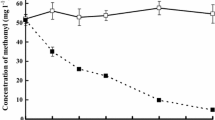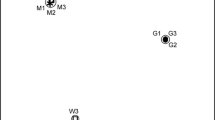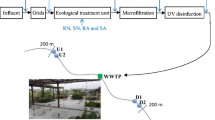Abstract
The present work aims at evaluating the ability of the River Tiber natural microbial community to degrade naproxen in water samples collected downstream from a wastewater treatment plant. For this purpose, different water microcosms were set up (microbiologically active vs sterile ones) and treated with naproxen (100 μg/L) alone or in the co-presence of gemfibrozil in order to evaluate if the co-presence of the latter had an influence on naproxen degradation. The experiment was performed in the autumn and was compared with the same experimental set performed in spring of the same year to highlight if seasonal differences in the river water influenced the naproxen degradation. Pharmaceutical concentrations and microbial analysis (total cell number, viability, and microbial community composition) were performed at different times in the degradation experiments. The overall results show that the natural microbial community in the river water had a key role in the naproxen degradation. In fact, although there was a transient negative effect on the natural microbial community in all the experiments (3 h after adding the pharmaceutical), the latter was able to degrade naproxen within about 40 days. On the contrary, no decrease in the pharmaceutical concentration was observed in the sterile river water. Moreover, the co-presence of the two drugs lengthened the naproxen lag phase. As regards the natural microbial community composition detected by Fluorescence in situ Hybridization, Alpha and Gamma-Proteobacteria increased when the pharmaceutical halved, suggesting their role in the degradation. This study shows that with the concentration studied, naproxen was degraded by the natural microbial populations collected from a river chronically contaminated by this pharmaceutical.




Similar content being viewed by others
References
Andreozzi R, Marotta R, Paxéus N (2003) Pharmaceuticals in STP effluents and their solar photodegradation in aquatic environment. Chemosphere 50:1319–1330
Aracagök YD, Göker H, Cihangir N (2013) Biodegradation of naproxen by Aspergillus niger and identification of some intermediates. Curr Opin Biotechnol 24, S1:S34.
Araujo L, Villa N, Camargo N, Bustos M, Garcìa T (2011) Persistence of gemfibrozil, naproxen and mefenamic acid in natural waters. Environ Chem Lett 9:13–18
Babut M, Arts GH, Barra Caracciolo A, Carluer N, Domange N, Friberg N, Gouy V, Grung M, Lagadic L, Martin-Laurent F, Mazzella N, Pesce S, Real B, Reichenberger S, Roex EW, Romijn K, Röttele M, Stenrød M, Tournebize J, Vernier F, Vindimian E (2013) Pesticide risk assessment and management in a globally changing world—report from a European interdisciplinary workshop. Environ Sci Pollut Res Int 20(11):8298–8312
Barra Caracciolo A, Grenni P, Cupo C, Rossetti S (2005) In situ analysis of native microbial communities in complex samples with high particulate loads. FEMS Microbiol Lett 253(1):55–58
Barra Caracciolo A, Bottoni P, Grenni P (2010) Fluorescence In Situ Hybridization in soil and water ecosystems: a useful method for studying the effect of xenobiotics on bacterial community structure. Toxicol Environ Chem 92:567–579
Barra Caracciolo A, Bottoni P, Grenni P (2013) Microcosm studies to evaluate microbial potential to degrade pollutants in soil and water ecosystems. Microchem J 107:126–130
Beausse J (2004) Selected drugs in solid matrices: a review of environmental determination, occurrence and properties of principal substances. Trends Anal Chem 23:753–761
Brozinski J-M, Lahti M, Meierjohann A, Oikari A, Kronberg L (2013) The anti-inflammatory drugs diclofenac, naproxen and ibuprofen are found in the bile of wild fish caught downstream of a wastewater treatment plant. Environ Sci Technol 47(1):342–348
Bueno MJ, Gomez MJ, Herrera S, Hernando MD, Agüera A, Fernández-Alba AR (2012) Occurrence and persistence of organic emerging contaminants and priority pollutants in five sewage treatment plants of Spain: two years pilot survey monitoring. Environ Pollut 164:267–273
Carballa M, Omil F, Lema JM (2008a) Comparison of predicted and measured concentrations of selected pharmaceuticals, fragrances and hormones in Spanish sewage. Chemosphere 72(8):1118–1123
Carballa M, Fink G, Omil F, Lema JM, Ternes T (2008b) Determination of the solid–water distribution coefficient Kd for pharmaceuticals, estrogens and musk fragrances in digested sludge. Water Res 42(1–2):287–295
Committee for Medicinal Products for Human Use (CHMP) (2006) European medicines agency pre-authorisation evaluation of medicines for human use (Doc. Ref. EMEA/CHMP/SWP/4447/00), Guideline on the environmental risk assessment of medicinal products for human use. http://www.ema.europa.eu/docs/en_GB/document_library/Scientific_guideline/2009/10/WC500003978.pdfAccessed 10 January 2014.
Cruz-Morató C, Ferrando-Climent L, Rodriguez-Mozaz S, Barceló D, Marco-Urrea E, Vicent T, Sarrà M (2013) Degradation of pharmaceuticals in non-sterile urban wastewater by Trametes versicolor in a fluidized bed bioreactor. Water Res 47(14):5200–5210
Daam MA, Cerejeira MJ, Van den Brink PJ, Brock TC (2011) Is it possible to extrapolate results of aquatic microcosm and mesocosm experiments with pesticides between climate zones in Europe? Environ Sci Pollut Res Int 18(1):123–126
Daneshvar A, Svanfelt J, Kronberg L, Weyhenmeyer GA (2010) Winter accumulation of acidic pharmaceuticals in a Swedish river. Environ Sci Pollut Res 17(4):908–916
de Voogt P, Janex-Habibi ML, Sacher F, Puijker L, Mons M (2009) Development of a common priority list of pharmaceuticals relevant for the water cycle. Water Sci Technol 59(1):39–46
Eiler A, Langenheder S, Bertilsson S, Tranvik LJ (2003) Heterotrophic bacterial growth efficiency and community structure at different natural organic carbon concentrations. Appl Environ Microbiol 69(7):3701–3709
Elifantz H, Malmstrom RR, Cottrell MT, Kirchman DL (2005) Assimilation of polysaccharides and glucose by major bacterial groups in the Delaware Estuary. Appl Environ Microb 71:7799–7805
Garcia-Rodríguez A, Matamoros V, Fontàs C, Salvadó V (2014) The ability of biologically based wastewater treatment systems to remove emerging organic contaminants—a review. Environ Sci Poll Res. doi:10.1007/s11356-013-2448-5
Gerbersdorf SU, Hollert H, Brinkmann M, Wieprecht S, Schuttrumpf H, Manz (2011) Anthropogenic pollutants affect ecosystem services of freshwater sediments: the need for a “triad plus x” approach. J Soils Sediments 11(6):1099–1114
Ginebreda A, Jelić A, Petrović M, López de Alda M, Barceló D (2012) New indexes for compound prioritization and complexity quantification on environmental monitoring inventories. Environ Sci Poll Res 19:958–970
Grenni P, Barra Caracciolo A, Rodríguez-Cruz MS, Sánchez-Martín MJ (2009a) Changes in the microbial activity in a soil amended with oak and pine residues and treated with linuron herbicide. App Soil Ecol 41:2–7
Grenni P, Gibello A, Barra Caracciolo A, Fajardo C, Nande M, Vargas R, Saccà ML, Martinez-Iñigo MJ, Ciccoli R, Martín M (2009b) A new fluorescent oligonucleotide probe for in situ detection of s-triazine-degrading Rhodococcus wratislaviensis in contaminated groundwater and soil samples. Water Res 43:2999–3008
Grenni P, Patrolecco L, Ademollo N, Tolomei A, Barra Caracciolo A (2013) Degradation of gemfibrozil and naproxen in a river water ecosystem. Microchem J 107:158–164
Grossberger A, Hadar Y, Borch T, Chefetz B (2014) Biodegradability of pharmaceutical compounds in agricultural soils irrigated with treated wastewater. Environ Pollut 185:168–177
Hahn MW (2006) The microbial diversity of inland waters. Curr Opin Biotechnol 17(3):256–261
Jianga J-Q, Zhoua Z (2013) Occurrence, transportation, monitoring and treatment of emerging micro-pollutants in waste water—a review from global views. Microchem J 110:292–300
Kirchman D, Dittel AI, Findlay SE, Fischer D (2004) Changes in bacterial activity and community structure in response to dissolved organic matter in the Hudson River, New York. Aquat Microb Ecol 35:243–257
Kraigher B, Kosjek T, Heath E, Kompare B, Mandic-Mule I (2008) Influence of pharmaceutical residues on the structure of activated sludge bacterial communities in wastewater treatment bioreactors. Water Res 42:4578–4588
Lin AYC, Reinhard M (2005) Photodegradation of common environmental pharmaceuticals and estrogens in river water. Environ Toxicol Chem 24:1303–1309
Lin K, Gan J (2011) Sorption and degradation of wastewater-associated non-steroidal anti-inflammatory drugs and antibiotics in soils. Chemosphere 83(3):240–246
Loos R, Gawlik BM, Locoro G, Rimaviciute E, Contini S, Bidoglio G (2008) EU wide monitoring survey of polar persistent pollutants in European river waters. European Commission, Joint Research Centre, Institute for Environment and Sustainability. http://bookshop.europa.eu/it/eu-wide-monitoring-survey-of-polar-persistent-pollutants-in-european-river-waters-pbLBNA23568/. Accessed 10 January 2014.
Loy A, Maixner F, Wagner M, Horn M (2007) probeBase—an online resource for rRNA-targeted oligonucleotide probes: new features 2007. Nucleic Acids Res 35:D800–D804
Luo Y, Guo W, Ngo HH, Nghiem LD, Hai FI, Zhang J, Liang S, Wang XC (2014) A review on the occurrence of micropollutants in the aquatic environment and their fate and removal during wastewater treatment. Sci Total Environ 473–474:619–641
Mascolo G, Balest L, Cassano D, Laera G, Lopez A, Pollice A, Salerno C (2010) Biodegradability of pharmaceutical industrial wastewater and formation of recalcitrant organic compounds during aerobic biological treatment. Bioresource Technol 101:2585–2591
Martín J, Camacho-Muñoz D, Santos JL, Aparicio I, Alonso E (2012) Occurrence of pharmaceutical compounds in wastewater and sludge from wastewater treatment plants: removal and ecotoxicological impact of wastewater discharges and sludge disposal. J Hazard Mater 239–240:40–47
Patrolecco L, Capri S, De Angelis S, Pagnotta R, Polesello S, Valsecchi S (2006) Partition of nonylphenol and related compounds among different aquatic compartments in Tiber River (Central Italy). Water Air Soil Poll 172:151–166
Patrolecco L, Ademollo N, Grenni P, Tolomei A, Barra Caracciolo A, Capri S (2013) Simultaneous determination of human pharmaceuticals in water samples by solid phase extraction and HPLC with UV-fluorescence detection. Microchem J 107:165–171
Pernthaler J (2013) Freshwater microbial communities. In: Rosenberg E, DeLong EF, Lory S, Stackebrandt E, Thompson F (eds) The Prokaryotes, 4th edn. XX, Springer Berlin Heidelberg, pp 97–112
Pomati F, Orlandi C, Clerici M, Luciani F, Zuccato E (2008) Effects and interactions in an environmentally relevant mixture of pharmaceuticals. Toxicol Sci 102(1):129–137
Proia L, Osorio V, Soley S, Köck-Schulmeyer M, Pérez S, Barceló D, Romaní AM, Sabater S (2013) Effects of pesticides and pharmaceuticals on biofilms in a highly impacted river. Environ Poll 178:220–228
Quintana JB, Weiss S, Reemtsma T (2005) Pathways and metabolites of microbial degradation of selected acidic pharmaceutical and their occurrence in municipal wastewater treated by a membrane bioreactor. Water Res 39:2654–2664
Radjenovic J, Petrovic M, Barcelo D (2009) Fate and distribution of pharmaceuticals in wastewater and sewage sludge of the conventional activated sludge (CAS) and advanced membrane bioreactor (MBR) treatment. Water Res 43:831–841
Radke M, Ulrich H, Wurm C, Kunkel U (2010) Dynamics and attenuation of acidic pharmaceuticals along a river stretch. Environ Sci Technol 44:2968–2974
Rodarte-Morales AI, Feijoo G, Moreira MT, Lema JM (2012) Biotransformation of three pharmaceutical active compounds by the fungus Phanerochaete chrysosporium in a fed batch stirred reactor under air and oxygen supply. Biodegradation 23(1):145–156
Rosal R, Rodea-Palomares I, Boltes K, Fernández-Piñas F, Leganés F, Gonzalo S, Petre A (2010) Ecotoxicity assessment of lipid regulators in water and biologically treated wastewater using three aquatic organisms. Environ Sci Poll Res 17:135–144
Ruiz-González C, Proia L, Ferrera I, Gasol JM, Sabater S (2013) Effects of large river dam regulation on bacterioplankton community structure. FEMS Microbiol Ecol 84(2):316–331
Schlabach M, Dye C, Kaj L, Klausen S, Langford K, Leknes H, Moe MK, Remberger M, Schøyen M, Thomas K, Vogelsang C (2009) Environmental screening of selected organic compounds 2008. Human and hospital-use pharmaceuticals, aquaculture medicines and personal care products. Norwegian Pollution Control Authority, SPFO-rapport: 1046/2009, 114 pp. http://www.miljodirektoratet.no/old/klif/publikasjoner/2508/ta2508.pdf. Accessed 15 January 2014.
Schweitzer B, Huber I, Amann R, Ludwig W, Simon M (2001) α- and β-Proteobacteria control the consumption and release of amino acids on lake snow aggregates. Appl Environ Microb 67:632–645
Straub JO, Stewart KM (2007) Deterministic and probabilistic acute-based environmental risk assessment for naproxen for Western Europe. Environ Toxicol Chem 26(4):795–806
Tiehm A, Schmidt N, Stieber M, Sacher F, Wolf L, Hoetzl H (2011) Biodegradation of pharmaceutical compounds and their occurrence in the Jordan Valley. Water Res Manag 25:1195–1203
Tixier C, Singer HP, Oellers J, Müller SR (2003) Occurrence and fate of carbamazepine, clofibric acid, diclofenac, ibuprofen, ketoprofen, and naproxen in surface waters. Environ Sci Technol 37:1061–1068
Topp E, Hendel JG, Lapen DR, Chapman R (2008) Fate of the nonsteroidal anti-inflammatory drug naproxen in agricultural soil receiving liquid municipal biosolids. Environ Toxicol Chem 27(10):2005–2010
Vieno NM, Tuhkanen T, Kronberg L (2005) Seasonal variation in the occurrence of pharmaceuticals in effluents from a sewage treatment plant and in the recipient water. Environ Sci Technol 39(21):8220–8226
Wang S, Gunsch CK (2011) Effects of selected pharmaceutically active compounds on the ammonia oxidizing bacterium Nitrosomonas europea. Chemosphere 82:565–572
Westerhoff P, Yoon Y, Snyder S, Wert E (2005) Fate of endocrine-disruptor, pharmaceutical, and personal care product chemicals during simulated drinking water treatment processes. Environ Sci Technol 39:6649–6663
Ying GG, Kookana RS, Kolpin DW (2009) Occurrence and removal of pharmaceutically active compounds in sewage treatment plants with different technologies. J Environ Monit 11:1498–1505
Acknowledgments
The authors thank Francesca Falconi and Antonella Tolomei for their useful contribution to the microbiological analysis and microcosm setup.
Author information
Authors and Affiliations
Corresponding author
Additional information
Responsible editor: Robert Duran
Rights and permissions
About this article
Cite this article
Grenni, P., Patrolecco, L., Ademollo, N. et al. Capability of the natural microbial community in a river water ecosystem to degrade the drug naproxen. Environ Sci Pollut Res 21, 13470–13479 (2014). https://doi.org/10.1007/s11356-014-3276-y
Received:
Accepted:
Published:
Issue Date:
DOI: https://doi.org/10.1007/s11356-014-3276-y




